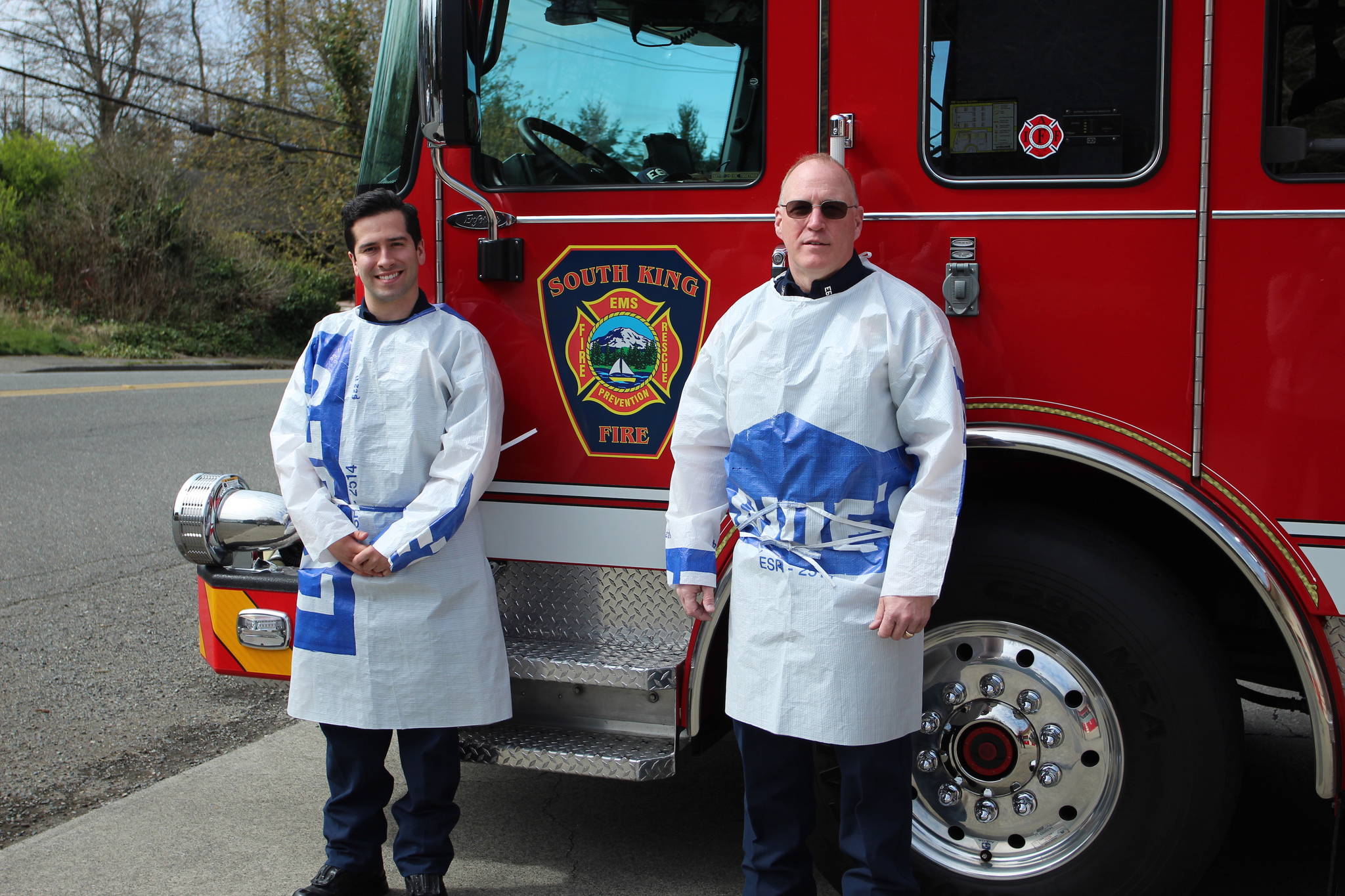A firefighter-operated sewing room at Station 65 is where South King Fire and Rescue is creating solutions to the protective gear shortage that many first responders are facing during the COVID-19 outbreak.
“You’ll find that we’re just all a bunch of problem solvers,” said SKFR Driver Engineer Jim Wilson. “That’s why people call us: they have a problem, we go out, we solve the problem. We’re the same way right now.”
First responders across the nation are facing a shortage of personal protective equipment (PPE) and the uncertainty of resupply is leading to unconventional solutions.
Most of the standard PPE (masks, eye protection, gowns and gloves) are one-time use items, and in a time of a virus outbreak, the burn rate of these resources is astronomical, department officials say.
In response, South King Fire and Rescue’s internal COVID-19 Task Force has designed and manufactured a disposable gown made from construction house wrap material, according to an April 6 news release.
SKFR Lieutenant Jan Nielson, Health and Safety Advisor for the SKFR COVID-19 Task Force, brainstormed the idea and shared it with the task force, then enlisted the talents of firefighter Wilson to design a prototype.
“We threw some ideas out there and we came up with this Tyvek house wrap material, which is designed to keep moisture out,” Wilson said.
The Lowe’s Home Improvement store in Federal Way donated 300 feet of Tyvek to the department for the alternative gowns. Tyvek is a high-density synthetic material typically used as a moisture barrier to protect buildings during construction.
“I came up with a pattern and sat down for a couple of hours and built a couple of [gowns], then tweaked it and built a couple more,” he said.
That amount of materials allows Wilson to create about 120-130 gowns.
“It took a lot of trial and error and a lot of botched up jobs, but it just kept growing to what you see now,” said Wilson, who has been with the department for 31 years.
Wilson’s wife is a seamstress, and Wilson watched her work for years. When a former fire chief picked up a sewing machine for the department more than 25 years ago, Wilson volunteered to figure it out.
Since then, “it grew from this one little machine in the corner of a closet, and now it’s a pretty nice shop.”
At Station 65, a garage-turned-sewing room is equipped with five sewing machines, rolls of material mounted to the walls, and Wilson’s good pair of scissors in a hidden spot. Surrounded by designs and creations strewn about, Wilson is at the center.
“There’s nothing that this department needs that I can’t give them at this point,” he said. “The nice thing is, I know what they need and I know how it needs to be used.”
Wilson has designed protective bags for firefighters to carry their equipment and handcrafted engine covers to protect fire hoses from weather elements.
He also hems pants, fixes uniforms, and sews on name tags and department patches, among other tailoring needs for the department.
“If it takes a sewing needle, I’m doing it,” he said.
When SKFR’s supply of gowns began to dwindle, members of the department’s COVID-19 Task Force looked to Wilson for a solution.
Each shift, crew members help cut out the three pieces of the gowns: the main body, the arms and the fastened tie strings, although Wilson is the sole seamster.
It takes Wilson about seven minutes to complete a gown and “before you know it, there’s a stack of them all ready to go.”
Because the garments are made of a plastic material, department members are working to find ways to safely make the gowns washable and reusable.
Based on the Centers for Disease Control and Prevention guidelines, SKFR’s Hazardous Materials Technical Safety Officer Lt. Greg Willett determined the construction-grade house wrap is appropriate as an alternative disposable gown material, according to SKFR.
“It’s not that we’re immediately critical, running low right now, but part of our job working within the COVID task force is to forecast and plan for worst case scenarios,” said Capt. Shane Smith, another member of the department’s virus task force.
Estimates of when the department may exhaust its resources vary because of the unpredictability of the virus, said Assistant Chief Dave Mataftin.
“If we can scale this and get large enough numbers that will make a real positive impact, I can see them being on the street in two weeks,” Mataftin said of the handmade gowns. “But it all depends on where this outbreak goes.”
Sourcing talent from within the department, SKFR has been able to develop a prototype for the gowns with a digitized copy of the pattern to distribute to other emergency partners in need.
“This is pretty unconventional thinking,” Mataftin said. “This is a product that’s not designed for this at all, but it’s close enough that we’re willing to make adjustments and make it work.”
Despite the success of the one-man team, South King Fire is looking for the community’s help.
The department is asking for about 20 volunteers, whether a company or individuals, with sewing machines and sewing ability to help make gowns.
Those interested in volunteering can contact Community Affairs Officer Lt. Andrew Lowen at Andrew.Lowen@southkingfire.org for more information.


